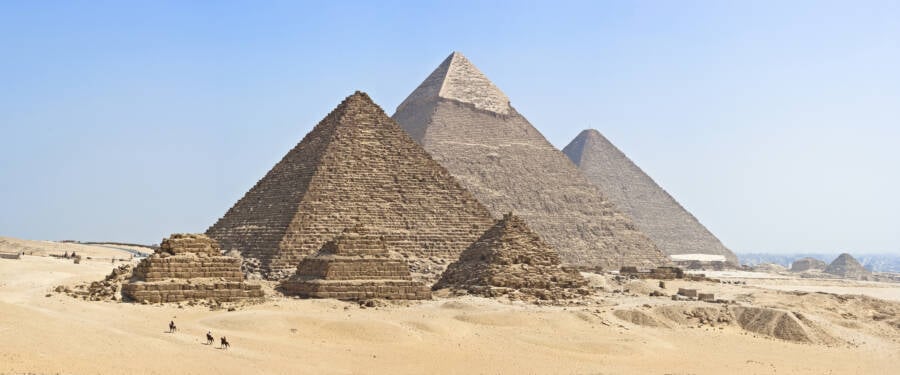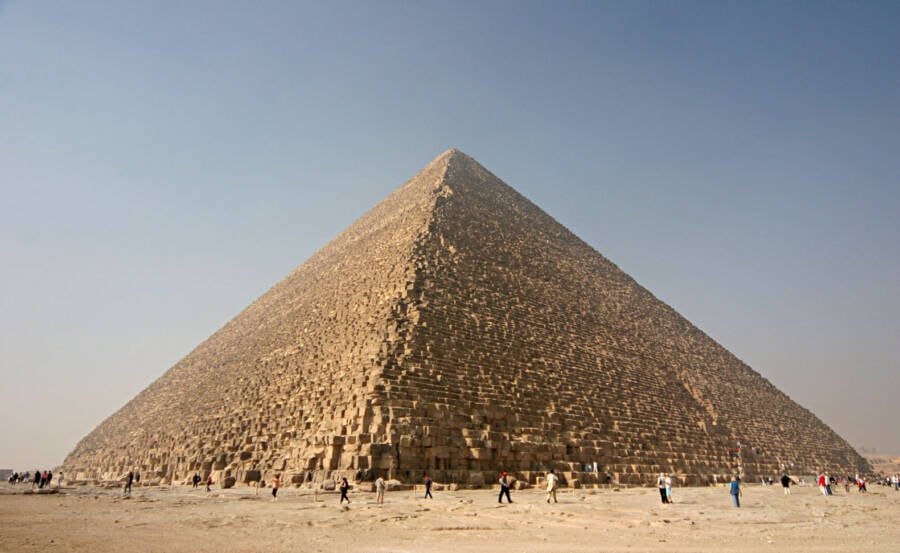When the Egyptian pyramids were built, woolly mammoths still walked the Earth, and iconic structures like the Great Wall of China and the Roman Colosseum were thousands of years away from being constructed.

Wikimedia CommonsThe Giza pyramid complex was built more than 4,500 years ago.
The pyramids of Giza are among the most fascinating ancient structures known to humankind. Countless questions have been raised over the years regarding the construction of the remarkable feats of engineering. When were the pyramids built? Who built them? How did they do it?
It’s widely agreed upon by modern science that humans — not extraterrestrials — built the pyramids by transporting materials along the Nile and wetting the sand to reduce friction while hauling the large stones across the desert. And while many historians once believed that the pyramids were built by enslaved laborers, modern research suggests the pyramids were actually built by skilled workers who were well-paid.
That covers the “who” and the “how,” the “where” is rather obvious, and it’s widely known why the ancient structures were built — as monuments to house the tombs of pharaohs. That leaves only one question remaining: When were the Egyptian pyramids built?
How Old Are The Pyramids? The Story Of The Pyramid Of Djoser, Egypt’s First
The pyramids weren’t all built at the same time. As far as modern archaeologists can tell, the very first pyramid built in Egypt was the step pyramid of Djoser in the Saqqara necropolis.
Unlike many other ancient structures, the Pyramid of Djoser was never “lost” to time. It has always been visible, and numerous archaeologists and historians over the years have studied it and recognized its historical importance. That said, it wasn’t until the early 20th century that researchers truly began efforts to study and preserve the tomb.

Charles J. Sharp/Wikimedia CommonsThe Pyramid of Djoser in Egypt’s Saqqara Necropolis.
One such figure was James Edward Quibell, who conducted excavations at Saqqara in the early 20th century. He published an extensive account of his research, including photographs and detailed recreations of various religious texts and hieroglyphs. Quibell’s research was then succeeded by individuals such as Cecil Mallaby Firth and Jean-Philippe Lauer, each of whom made substantial contributions to understanding the pyramid’s construction and history.
Through a combination of historical records, architectural analysis, and stratigraphy — the study of rock layers — researchers were able to determine the age of the Pyramid of Djoser. Ancient Egyptian historical texts and king lists, such as the Turin King List and the Palermo Stone, helped researchers interpret the timeline of the Old Kingdom pharaohs, which showed that Djoser had ruled during the Third Dynasty, from around 2670 to 2650 B.C.E.
An examination of the stratigraphic layers around the pyramid, as well as items found within it, corroborated this timeline. Moreover, the design of the structure itself suggests it was created at an earlier point in time than the pyramids of Giza.
The architecture of the step pyramid is most commonly attributed to Imhotep, Djoser’s chancellor. Imhotep is often credited as one of the earliest architects in history, and it’s easy to see why. The step pyramid, as its name suggests, does not share the relatively smooth sides of the structures that followed. Instead, it consists of six layers stacked on top of each other, creating a stepped appearance — an innovative technique for the time that would go on to signify a shift from traditional mastaba tombs to far grander burial complexes.
Notably, as Egyptologist Miroslav Verner explains in his 1997 book The Pyramids: The Mystery, Culture, and Science of Egypt’s Great Monuments, around the time of Djoser’s rule, the influence of the Sun cult and the Sun god Ra was growing rapidly. Perhaps, he and others have suggested, this newfound prevalence led worshipers to desire to build monuments that reached into the sky.
In any case, the Pyramid of Djoser marked the beginning of a new era for the Egyptians.
When Were The Pyramids Of Giza Built?
It didn’t take long for the trend Imhotep started to catch on. Sometime around 2575 B.C.E., construction began on the largest of the pyramids of Giza, the Great Pyramid. Dedicated to the pharaoh Khufu, who ruled during the Fourth Dynasty, the ancient tomb remained the largest man-made structure in the world for more than 3,800 years at 481 feet tall.

Wikimedia CommonsThe Great Pyramid of Giza was built as the tomb of the pharaoh Khufu.
In all, it is estimated that roughly 2.3 million blocks of limestone and granite — some weighing nearly 90 tons — were used in its construction.
The Great Pyramid was followed shortly thereafter by the Pyramid of Khafre, named for the Fourth Dynasty pharaoh and Khufu’s son. At 471 feet, it was just 10 feet shorter than the Great Pyramid.
The tomb is itself impressive, but it is more well known for its association with the Great Sphinx, a massive limestone statue with the body of a lion and the head of a pharaoh, believed by many to represent Khafre himself. The Sphinx is the oldest known monumental structure in Egypt, though it should be noted that historians have no clue what the ancients of the Old Kingdom called it. The word “Sphinx” comes to us from classical antiquity, some 2,000 years after its construction, referring to a similar creature from Greek myth.

Wikimedia CommonsThe Pyramid of Khafre in Giza, with the Great Sphinx standing in front.
The last of the pyramids of Giza is the Pyramid of Menkaure, dedicated to the pharaoh who succeeded Khafre (and possibly his son). It is the smallest of the three tombs, standing just 213 feet tall and located several hundred yards away from the others. Unfortunately, much of Menkaure’s rule was also poorly documented, meaning the historical record is not as exact when it comes to his tomb. However, the structure is notable for the exceptionally high-quality materials used in its construction.

Wikimedia CommonsThe Pyramid of Menkaure.
The granite blocks that make up its lower layers, some of which weigh several tons, were transported from a quarry in Aswan, located about 500 miles south of Giza, while the upper portions of the structure were constructed with Tura limestone, which was originally polished to a smooth finish when the pyramids were built.
In recent years, work has been undertaken to further preserve and protect the pyramids from damage, but it’s fortunate that they still stand today at all: In 1196 C.E., the second Ayyubid Sultan of Egypt, Al-Aziz Uthman attempted to destroy them.
The Attempted Destruction Of The Ancient Wonders At Giza
By the late 12th century, the pyramids of Giza were already considered to be ancient monuments, having stood for more than three millennia. Most cultures looked upon the tombs with reverence as a symbol of Egypt’s long and storied past. The same could not be said for Sultan Al-Aziz Uthman.
Al-Aziz Uthman, son of Saladin, viewed the pyramids as pagan symbols from a pre-Islamic era. To him, they were remnants of idolatry, and he sought to destroy them to bring Egypt more in line with his religious beliefs.
His plan was to begin with the Pyramid of Menkaure. Al-Aziz Uthman mobilized a substantial workforce of laborers armed with destructive tools and set about trying to dismantle Menkaure. Unfortunately for the Sultan — and fortunately for just about everyone else — the task was much more difficult than he had anticipated. Not only did the engineering that went into the pyramids’ construction make it inefficient to break them apart, but the materials themselves were extremely hard.

Daniel Mayer/Wikimedia CommonsDamage incurred by the Pyramid of Menkaure during Al-Aziz Uthman’s attempted destruction.
While Al-Aziz Uthman’s laborers managed to partially damage the Pyramid of Menkaure and remove some of the casing stones, the effort was ultimately minimal compared to the overall size of the pyramid — and it was the smallest of the three.
Realizing the enormity of the task ahead of him, Al-Aziz Uthman abandoned the project, and the pyramids stand to this very day, nearly 5,000 years after they were built.
After learning about when the pyramids were built, check out some amazing pyramids that aren’t in Egypt. Or, dive into the story behind the controversial construction of the Eiffel Tower.





